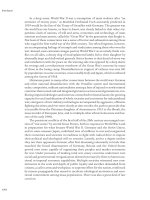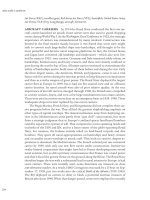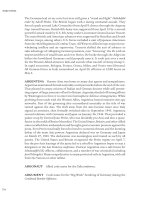The concise encyclopedia of world war II 2 volumes (greenwood encyclopedias of modern world wars) ( PDFDrive ) 246
Bạn đang xem bản rút gọn của tài liệu. Xem và tải ngay bản đầy đủ của tài liệu tại đây (73.41 KB, 1 trang )
Blockade Running
run away to the countryside to look for food and that in any case lacked resources
to continue production. Blockade thus not only seriously disrupted Japanese production, it reduced the population to near-starvation levels by mid-1945.
See also blockade runners; convoys; Leningrad, siege of; Phoney War; Switzerland;
U-boats.
BLOCKADE RUNNING Smuggling is an ancient and honorable profession.
Blockade running is smuggling by neutrals or belligerents in time of war. In a truly
global war such as World War II, that became a far more deadly game than usual.
Sometimes, it was a last resort. For instance, the British used submarines to run
critical aircraft fuel into Malta during the siege of that island base because their
tanker convoys were savaged by Italian and German air attack. Americans used private ships from the Dutch East Indies to move supplies in to Corregidor and fast PT
boats to get General Douglas MacArthur out. Smuggling operations supported isolated coast watchers in the South Pacific. The British also used submarines and small
craft to smuggle in spies and commando teams and to supply resistance movements with arms in German-occupied Europe. Résistance leaders were smuggled in
to take control of fractious local movements in France and out to brief officials in
London. Several Norwegian surface blockade runners made a dangerous passage
from Sweden, carrying vital finished war matériel to Great Britain in January 1941.
They were bombed, but survived. A second run from Sweden in March 1942, by 10
Norwegian ships with British crews, was a disaster: only two vessels completed the
voyage after encountering neutral Swedish and hostile German armed opposition.
Later in the war, as Sweden sidled more toward the Western Allies with the obvious
approach of German defeat, British Motor Gun Boats (MGBs) operated by the Special
Operations Executive (SOE) made a number of dashes to Sweden and back.
Blockade running was mostly unattractive to neutral shipping once Allied
naval supremacy was established. But Axis blockade runners—on and below the
water—operated wherever enemy surface navies or land-based aircraft intercepted
regular maritime traffic. They concentrated on critical raw materials and other contraband goods. One German blockade runner was caught disguised as a U.S. ship.
Japanese–German blockade breaking was facilitated by the Soviet Union until June
1941. The Japanese also ran materials to Germany by surface ship, especially natural rubber but also vegetable oils. The first surface blockade runner left Japan for
France on December 28, 1940. It did not arrive in Germany until April 4, 1941. Operation BARBAROSSA shut down the trans-Siberian rail route from Manchuria to
Germany from the end of June 1941. Seventeen Japanese ships were then sent west,
carrying enough natural rubber to serve as a base for the German synthetic rubber
program for two years. The Germans asked for even more blockade runners, but
only a few Japanese dozen ships were sent out in 1942. Their loses rose steeply during 1943. German goods went back to Japan in surviving ships. This surface trade
ceased entirely in January 1944. Yet, the small amounts of rubber, tin, and wolfram
sent to Germany before then proved critical to continued war production in 1944.
After cancellation of the surface trade, U-boats and converted Italian submarines
were used. Obvious limitations of space and improved Western Allied anti-submarine
169









